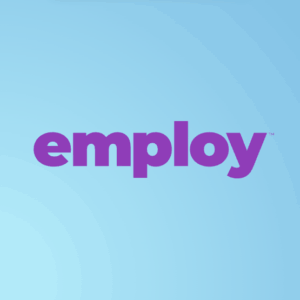Bright lights weren’t all that shined in Las Vegas at HR Tech 2025—the ideas and innovations in talent acquisition flowed like champagne at the hottest nightclub. We soaked it all up, then spilled the best of it in our webinar, HR Tech 2025: Bold Bets, Big Shifts, and What’s Next for TA.
Employ’s own Chief People Officer, Stephanie Manzelli, teamed up with Ben Olson, Senior Director of TA at LinkedIn, and Ben Eubanks, Chief Research Officer at Lighthouse Research & Advisory, to unpack five trends that every talent pro needs to keep on their radar.
Keep scrolling for the highlights, the hot takes, and the real-world examples.
Trend 1: Candidate Fraud is Up
Candidate fraud—everything from AI-generated resumes to deepfake interviews—is officially a boardroom topic.
According to research from Lighthouse, eight in 10 employers can’t reliably spot an AI-created resume. Yikes. As part of that research, Ben Eubank’s team asked the HR field, “What is cheating to you?” They said using AI to answer assessments or give them answers during interviews, and rewriting resumes to match the job description when they don’t truly have those skills.
Talk to recruiters these days and you’ll hear stories of candidate fraud pop up left and right. And with quickly evolving AI, some trends are catching recruiters off guard. There are some basic things you can do to protect yourself.
“For example, if a candidate has a virtual Zoom background, you can ask them to basically restore their background to their normal camera view,” said Ben Olson. “Or you can take more drastic measures, and a lot of companies are actually returning to in person interviewing.”
Bottom line, a lot of companies today are figuring out what’s the right solution for them, and there’s no one-size-fits-all. What matters most is approaching the process thoughtfully to ensure a positive outcome for both the job seeker and the employer.
Trend 2: Responsible AI Use is Good AI Use
Sixty-four percent of organizations are already using AI across recruitment, interviewing, and hiring, according to the Society for Human Resource Management. But here’s the shift: the hype cycle is giving way to AI governance.
Ben Olson’s team at LinkedIn uses AI for tasks like interview transcription, so that recruiters can spend the interview fostering connection with a candidate instead of jotting down notes. They are also “customer zero” for LinkedIn’s new AI hiring agent, LinkedIn Hiring Assistant. Early customers using Hiring Assistant are seeing strong results: 62% fewer profiles viewed to find a qualified match, 69% higher InMail acceptance rate, and 48% less time reviewing applications. And importantly, it’s built with LinkedIn’s Responsible AI Principles at its core.
Ben Eubanks reminds leaders: If AI is bringing you a task, double-check its work. Know what problem you’re solving before you throw AI at it. Transparency and accountability aren’t optional.
And if you’re going to adopt AI, one thing you must have a good handle on is making sure your AI screens and evaluates candidates without bias. When asked, candidates prefer AI consent language that is protective, as Ben Eubanks explains:
You have to ask the vendor the right questions to make sure you trust the platform.
“One of the things that Employ does is we actually partner with IBM to embed watsonx directly into our products, and that is always on AI accountability,” Stephanie said. “And so, as you’re evaluating the AI tools that each of you are choosing to implement in your organization, what are the vendors offering you? That’s a really great question that you should be asking all of the partners that you’re considering working with, because this conversation is not going away.”
Trend 3: Making Skills-Based Hiring Work
Speaking of AI, it’s a skillset that many organizations are hiring for. In fact, LinkedIn is building a new framework to assess the AI fluency levels of every candidate they meet. Their goal is to make AI skills-screening fair and scalable as they transition to becoming a fully AI-native workforce.
Here’s how it works:
*Bonus tip* If you’re a Jobvite, Lever or JazzHR customer, you’ll be able to see skills data from LinkedIn (including AI skills) to easily spot qualified candidates during an applicant review once you enable the Apply Connect integration.
For Stephanie, skills-based hiring is about understanding your process, your business, and the roles you’re hiring for. And at the heart of that, think about the skills necessary to be successful and how they align with your candidate persona.
“You know, many moons ago, I used to staff entry level HR talent only with hospitality workers and restaurant and retail workers,” Stephanie said. “I would go out and find them because if you can deal with customers all day long, you can do HR all day long. They did not have the skill sets to do entry level HR roles. However, at the end of the day, they had the core fundamentals, which were going to be critical to our success.”
Trend 4: Flexibility is How You Close Talent Gaps
Even with tech innovations, the labor market is still facing shortages in sectors like health care, logistics, and trade. At HR Tech, this was a big topic. The consensus? Flexibility is the solution.
From a worker’s perspective, Ben Eubanks says flexibility comes down to three priorities: “How I work, when I work, and how I grow.”
Employees understand that they have responsibility for the outcome, but they want autonomy in how the work gets done. Similarly, the workforce wants flexibility in the time of day they can get that work done.
The “how I grow” priority is a little less straightforward.
“Do I have a chance to bungee into another role? Do I have a chance to build a new skill? Do I have a chance to try something new?” That’s what’s top of mind for employees when it comes to their growth, Ben Eubanks says.
Today, many employees are looking for new ways to grow their careers in slower hiring cycles. At LinkedIn, Ben Olson says they’ve started experimenting with an “internal job board” to post short-term projects that allow employees to gain new career experiences that will help them grow.
Take notes from this genius idea:
The bottom line? Deciding what flexibility looks like for your talent is critical to determining the success of your staffing strategy.
Trend 5: Using ROI Proof Points to Prove TA’s Business Impact
One of the loudest conversations at HR Tech was proving TA’s ROI on the organization as a whole.
Ben Olson emphasized the importance of going beyond easy-to-measure vanity metrics and instead focusing on the outcomes that leaders care about the most. To answer that, he shared a valuable acronym he learned from a marketing leader: HVA, or high value actions—which are the most important business outcomes that your team is trying to drive. For example, his goal is to begin tracking and reporting on the talent HVAs that are most important to TA leaders, like how many qualified candidates his team is moving into a higher priority pipelines.
Ben Eubanks’ research points to a framework they call LIFT—the four elements that set apart companies nailing their data storytelling:
- Leadership buy in
- Insights, not just data
- Frame the narrative
- Technology enabled
Hear Ben Eubanks break down LIFT:
Data matters, but how you tell the story matters more.
Where Does TA Go From Here?
If HR Tech 2025 made one thing clear, it’s this: TA leaders aren’t just filling seats—they’re shaping the future of work.
From sniffing out candidate fraud to holding AI accountable, from making skills the new currency to giving employees growth paths that matter, TA has officially graduated from “back office” to “boardroom strategy.”
The takeaway? Don’t wait for these trends to trickle down. Get in front of them. Experiment. Ask harder questions of your vendors. Build flexibility into your strategy. Prove your impact with data that can’t be ignored.
Because in 2026, talent isn’t just an HR priority. It’s a business survival strategy.




